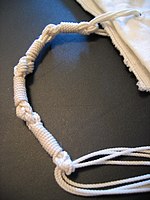Ẓiẓit

Tzitzis
|
|
| Halakhic texts relating to this article | |
|---|---|
| Torah: |
Numbers 15:38 and Deuteronomy 22:12 |
| Babylonian Talmud: | Menachos 39-42 |
| Mishneh Torah: | Ahavah (Love): Tzitzit |
| Shulchan Aruch: | Orach Chayim 8-25 |
Tzitzit [tsiˈtsit] (Hebrew: ציצית, Modern tsitsit Tiberian sˤisˤiṯ; plural tsitsiyot) are specially knotted ritual fringes, or tassels, worn in antiquity by Israelites and today by observant Jews and Samaritans. Tzitzit are attached to the four corners of the tallit (prayer shawl) and tallit katan (everyday undergarment).
Other pronunciations include Biblical and Middle Eastern (i.e., Mizrachi): ṣiṣit (pl. Ṣiṣiyot), Spanish and Mediterranean (i.e., Sephardic): tzitzit; European and Yiddish (i.e., Ashkenazi): tzitzis; Yemenite (i.e., Temani): ṣiṣith; Samaritan: ṣeṣet.
The word may derive from the semitic root N-TZ-H. The ending -it is the feminine adjectival suffix, used here to form a feminine singular noun. N-TZ-H comes from the root word for "flower" and originally meant a "tassel" or "lock", as in the Book of Ezekiel where Ezekiel is picked up by an angel and carried by a "lock" (Hebrew tzitzit) of hair. In English-language academic texts on Judaica the term is sometimes rendered "show-fringes". In the Hebrew Bible the use is singular, but the feminine plural tzitziyot is found in later texts. The Septuagint translation is "tassels" (Greek plural kraspeda κράσπεδα, from kraspedon κράσπεδον singular).
...
Wikipedia
